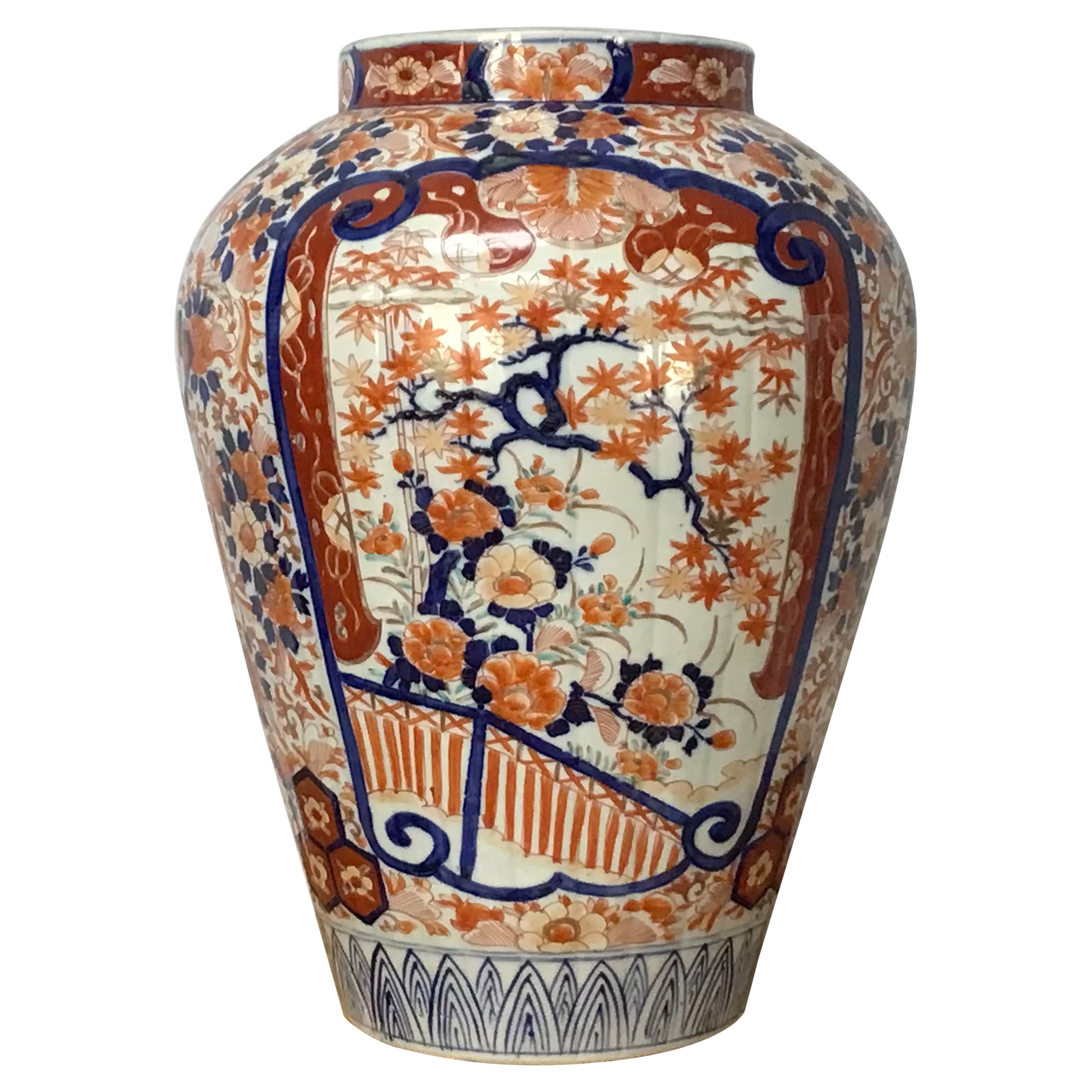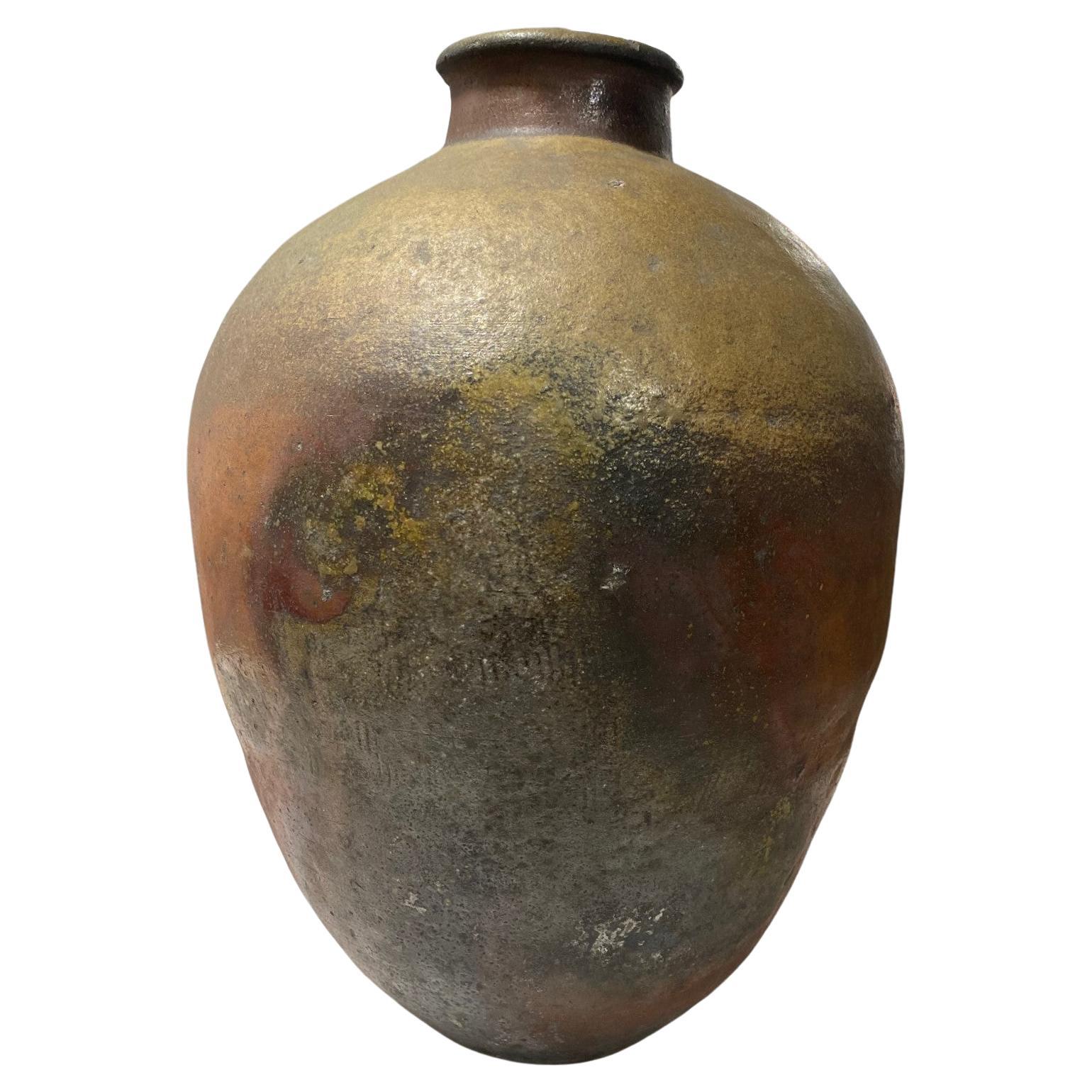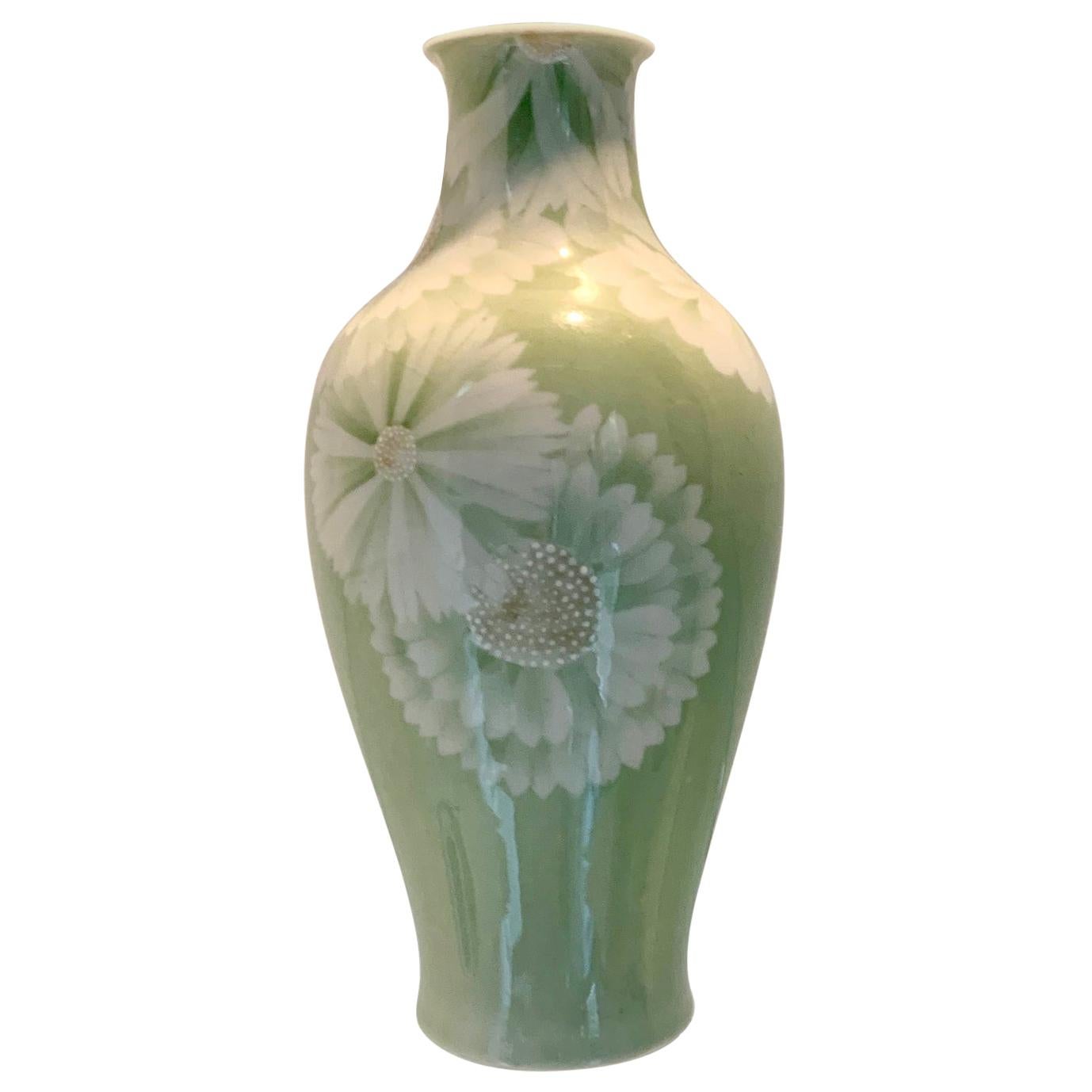Items Similar to Large Japanese Meiji Kyo-Ware Porcelain 'Tsubo' Vase by Kanzan Denshichi 幹山伝七
Want more images or videos?
Request additional images or videos from the seller
1 of 16
Large Japanese Meiji Kyo-Ware Porcelain 'Tsubo' Vase by Kanzan Denshichi 幹山伝七
About the Item
Tall and exceptionally made Kyo-ware porcelain jar (tsubo) with a naturalistically relief design of a coral-coloured net stretched around the body. On the shoulder hangs a beautifully draped red glazed cloth with a gilded decor of dragons and phoenixes surrounded by scrolling foliage. Around the neck the cloth and net are securely fastened by a thick cord ending in a big ornate knot.
Bottom mark: 'Dai Nippon Kanzan Sei' (Made in Imperial Japan by Kanzan). This mark is associated with the kiln of Kanzan Denshichi (1821-1890), a well-known Meiji Period porcelain artist and protégé of Makuzu Kozan.
Kanzan Denshichi (1821-1890): Born in the ceramic-producing area of Seto, joined the Koto ware kiln in Hikone domain, moving to Kyoto when the kiln closed in 1862. In Kyoto, he established his workshop at the base of Kiyomizu-zaka and is thought to have been one of the first ceramicists in Kyoto to specialise in porcelain production. At its peak, Kanzan’s workshop had up to 100 craftsmen, but mismanagement led to the dissolution of the workshop in 1889, and Kanzan died a year later?
When shipped we will add a certificate of authenticity.
Price including insured shipping.
- Creator:Kanzan Denshichi 幹山伝七 (Artist)
- Dimensions:Height: 18.9 in (48 cm)Diameter: 13 in (33 cm)
- Materials and Techniques:
- Place of Origin:
- Period:
- Date of Manufacture:Early Meiji period
- Condition:Wear consistent with age and use. In a very good condition. Please look at the photos for a condition reference.
- Seller Location:Amsterdam, NL
- Reference Number:
About the Seller
5.0
Vetted Seller
These experienced sellers undergo a comprehensive evaluation by our team of in-house experts.
Established in 1996
1stDibs seller since 2022
16 sales on 1stDibs
Typical response time: 10 hours
- ShippingRetrieving quote...Ships From: Amsterdam, Netherlands
- Return PolicyA return for this item may be initiated within 14 days of delivery.
More From This SellerView All
- Japanese Kutani-Ware Porcelain Vase by the Famous Tokuda Yasokichi III 三代徳田八十吉By Yasokichi Tokuda IIILocated in Amsterdam, NLMagnificent Kutani-ware porcelain vase of broad bluster shape by the famous artist Tokuda Yasokichi III (Masahiko) (1933-2009). Its body decorated wit...Category
20th Century Japanese Ceramics
MaterialsPorcelain
- Large Japanese Contemporary Porcelain Vase with a Blue & Gold Swirl DesignLocated in Amsterdam, NLVery large rotund-shaped porcelain vase with horizontal ribs and a covering underglaze design of overlapping swirls with a canvas pattern on a white ground. Heightened by gold lustre...Category
Late 20th Century Japanese Ceramics
MaterialsPorcelain
- Japanese Kutani-Ware Porcelain Vase by the Famous Tokuda Yasokichi III 三代徳田八十吉By Yasokichi Tokuda IIILocated in Amsterdam, NLFantastic, and very large Kutani-ware porcelain globular vase with horizontal ribs by the famous artist Tokuda Yasokichi III (Masahiko) (1933-2009). I...Category
Late 20th Century Japanese Ceramics
MaterialsPorcelain
- Unique & Large Japanese Oribe-ware Chair by Suzuki GorôBy Goro Suzuki 1Located in Amsterdam, NLImportant and rare Japanese irregular shaped ceramic Oribe-ware chair with various designs in orange, white and black colours by the famous Japanese ceramist Suzuki Gorô...Category
Mid-20th Century Japanese Ceramics
MaterialsStoneware
- Japanese glazed stoneware 'gu'-shaped vase by Minegishi Seikô 峯岸勢晃 (1952-2023)By Minegishi Seikô 峯岸勢晃Located in Amsterdam, NLExquisite stoneware vase of ‘gu’-like shape by the honoured artist Minegishi Seikô (1952-2023) with an undulating calyx-shaped mouth and covered by his trademark celadon glaze of grey-greenish colour. This high quality ‘kan’nyû’-type craquelé glaze looks like many stacked crystalized flakes surrounded by a faint reddish line. Creating a beautiful depth. The upper and lower rims, and the lower lying parts of the low relief lobed neck accentuated by smoky grey lines. The smooth foot decorated with two subtle rows of dots in the same shade. The bottom with an unglazed cartouche sealed by the artist. Minegishi Seikô was born in 1952 in Misato City, Saitama Prefecture. He specialised in craquelure celadon glaze, which was infamously difficult to achieve. His thickly applied glazes ranged from the classical range of celadon colours from pale green to grey to beige and were characterised by kan’nyū, or deep crackling that served to emphasise his elegant shapes. Minegishi's early work was in kohiki vessels (an iron-rich body coated in thin white slip glazes) inspired by early Korean pun'chong wares, rather than celadon glazes. After seeing a Chinese celadon bowl...Category
Late 20th Century Japanese Ceramics
MaterialsCeladon, Stoneware
- Outstanding Japanese Biomorphic Abstract Sculpture by Harumi Nakashima 中島晴美By Harumi NakashimaLocated in Amsterdam, NLOutstanding and large porcelain biomorphic abstract sculpture covered in clear glaze and regularly distributed opulent cobalt blue polka dots of varying sizes, titled ‘Twisting Back, Multiplying’, hand-built by the highly praised Japanese ceramic artist Harumi Nakashima (1950). Signed at the bottom in a dot '1104 Haru'. Made in 2011. Documented on the website of the artist himself. Born in 1950 in Ena, Gifu Prefecture, Harumi Nakashima is known for his biomorphic porcelain sculptures decorated with opulent blue dots. He excels in clay creations far removed from both tradition and functionality. Taking great care to achieve a flawless surface and form, each piece is created over the course of six months. Nakashima's early reputation was cemented as one of the leading teachers at the Tajimi Pottery Design and Technical Center, having trained and influenced many of the promising young ceramicists of Japan since 1976. Nakashima has received leading prizes and tributes. With works collected by 20 public institutions the world over, including the Museum of Arts and Design in New York and the Faenza Ceramics Museum in Italy, he is one of Japan's most celebrated porcelain artist. Influenced by the blue sometsuke (under-glaze) motifs of traditional Japanese porcelain, Nakashima's motifs also use cobalt blue over-glaze. Yet unlike traditional methods, Nakashima's blue dots are painted over the body of a work after the main firing, and then fired into the white glaze of the porcelain with a second firing using the technique of "in-glazing", thereby leading to the sinking of the dots upon the white overglaze. Perhaps more surprising is the fact that his organic, sprawling and fluid porcelain bodies are entirely hand-built. As porcelain is extremely difficult to manipulate by free-hand, Nakashima intentionally uses this method to create not only tension, but an epic "battle with clay". He is currently based in the port city of Nagoya, and some of his more recent exhibitions are; 2021 Art Market San Francisco, Duane Reed Gallery...Category
2010s Japanese Ceramics
MaterialsPorcelain
You May Also Like
- Large 19th Century Japanese Imari Ware Porcelain VaseLocated in Bradenton, FLA large scale and very good quality late 19th century Japanese Imari vase with exotic birds, trees and flowers. Wonderful coloring in vibrant hues of blue, red and rust.Category
Antique 19th Century Japanese Japonisme Ceramics
MaterialsPorcelain
- Japanese Antique Edo Wabi-Sabi Bizen Ware Large Art Pottery Jar Tsubo Pot VaseLocated in Studio City, CAAn absolutely stunning Bizen ware stoneware vase/tsubo jar/vessel - produced sometime during the mid to late Edo period (1603-1867). Bizen yaki ware is a ty...Category
Antique Mid-19th Century Japanese Edo Ceramics
MaterialsPottery, Stoneware
- Japanese Porcelain Vase Makuzu Kozan Meiji PeriodBy Makuzu KozanLocated in Atlanta, GAA striking blue and white vase from the studio of Japanese Potter Makuzu Kozan, also known as Miyagawa Kozan (1842–1916), one of the most established and collected ceramist from Meiji Period. Born as Miyagawa Toranosuke, Kozan established his pottery studio in Yokohama circa 1870s and later became one of the appointed artists to the Japanese Imperial household. His work was exhibited in many international fairs that the Meiji government participated at the turn of the century and won many grand prizes. Of a relatively large size, this vase is decorated with underglaze cobalt blue using the novel technique developed by Kozan called Fuki-e (the blow painting). As a result, the bamboos appear took on a three-dimensional quality as if appearing in a mist. Known as one of the most creative ceramists, circa 1887, Kozan started experimenting with new chemical colors from the West in the format of his porcelain glaze. New colors allowed him to create underglaze design that appeared bright, smooth and glossy. He even invented his own receipt of cobalt blue to achieve a much brighter yet softer shade, as evident on this vase. To create landscape that is realistic and dimensional, more common in the western paintings, he was inspired by the native Japanese ink painting technique developed around 1900 by Yokoyama Taikan...Category
Antique Early 1900s Japanese Japonisme Ceramics
MaterialsCeramic
- Japanese Porcelain Vase Meiji Period Makuzu KozanBy Makuzu KozanLocated in Atlanta, GAA finely decorated and glazed Japanese porcelain vase by Makuzu Kozan (1842-1916) circa 1900s Meiji Period. The vase is of a classic bottle form with baluster body and short neck. It was decorated with underglaze white magnolia blossom on a pleasant celadon background. The stamens of the flower were artistically rendered in a low relief, giving the design a realistic appeal with the dimension. Miyagawa Kozan...Category
Early 20th Century Japanese Meiji Ceramics
MaterialsPorcelain
- Japanese Antique Momoyama Edo Bizen Ware Pottery Wabi-Sabi Art Tsubo Jar VaseLocated in Studio City, CAAn absolutely stunning Bizen ware stoneware vase/jar/vessel - produced sometime during the late Momoyama period (1568-1600) / Early Edo Period (1603-1867). Bizen yaki...Category
Antique 16th Century Japanese Edo Ceramics
MaterialsStoneware
- Large Japanese Antique Shigaraki Tsubo JarLocated in Atlanta, GAAn antique Japanese stoneware storage jar, known as tsubo from Shigaraki kiln, circa 17th-18th century (early Edo possibly Momoyama period)....Category
Antique 17th Century Japanese Japonisme Ceramics
MaterialsCeramic





